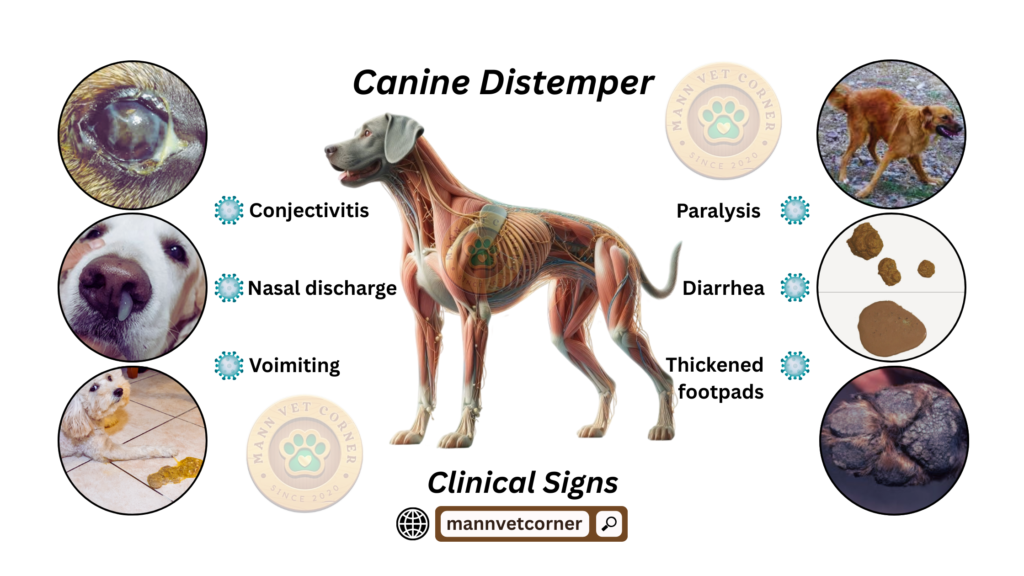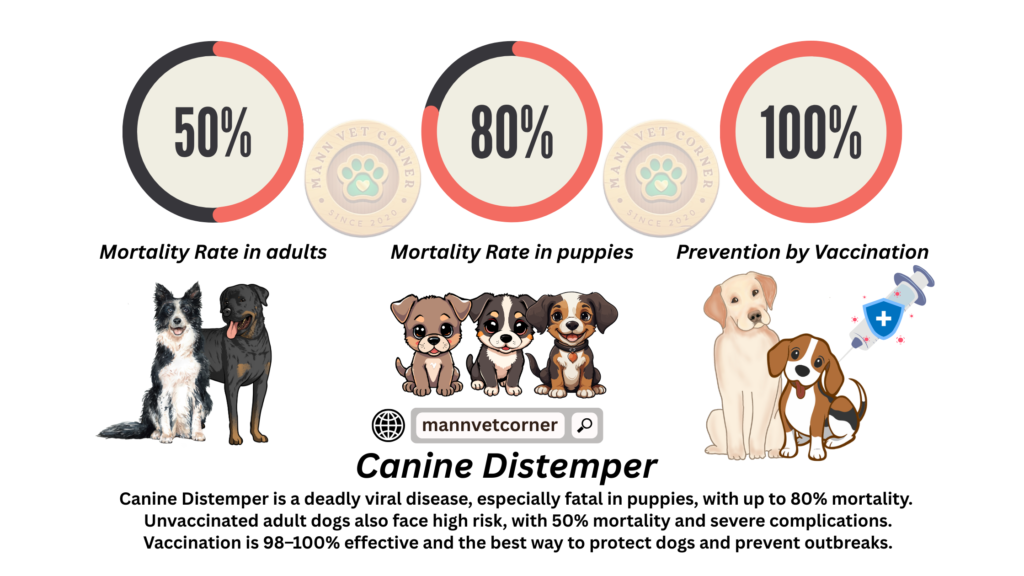Canine Distemper is a highly contagious and often fatal viral disease that affects dogs and other animals. It’s caused by the Canine Distemper Virus (CDV), a member of the paramyxovirus family. This disease can strike fear into the hearts of dog owners due to its severe symptoms and high mortality rate. In this blog, we’ll explore everything you need to know about Canine Distemper, from its causes and symptoms to its treatment and prevention.
Etiology
Canine Distemper has plagued dogs for centuries, but it wasn’t until 1905 that French veterinarian Henri Carré identified its cause: the Canine Distemper Virus (CDV). This virus belongs to the paramyxovirus family, alongside viruses responsible for measles in humans and rinderpest in cattle. CDV is an enveloped, single-stranded RNA virus, which makes it fragile—it can be destroyed by heat, light, and common disinfectants. Yet, in cool, shaded areas, it can survive long enough to infect new hosts. The virus spreads mainly through direct contact with an infected animal or its bodily fluids, like saliva, urine, or respiratory droplets. It can also travel on contaminated objects, such as food bowls, bedding, or even clothing, posing a serious risk in places like kennels and shelters.
Host Susceptibility
Dogs are the primary targets of Canine Distemper, but the virus doesn’t stop there. Wild canids—like foxes, wolves, and coyotes—are also at risk, and outbreaks can devastate wildlife populations. Beyond canids, CDV can infect ferrets, raccoons, skunks, and even some big cats, such as lions and tigers, though these cases are less common. Among dogs, puppies aged 3 to 6 months are especially vulnerable, particularly if unvaccinated. This age group loses maternal antibodies, leaving them exposed before their own immune systems fully develop. Some breeds, like Siberian Huskies and Alaskan Malamutes, may face higher risks due to genetic factors, but no dog is safe without vaccination. In crowded settings—like shelters or multi-pet homes—the virus spreads quickly, highlighting the need for vaccines and good hygiene.
Incubation Period
When a dog catches the Canine Distemper Virus, symptoms don’t appear right away. This delay, called the incubation period, lasts typically from 7 to 14 days, though it can range from 3 to 21 days. During this time, the virus multiplies and spreads inside the body. An infected dog might look healthy but can still shed the virus, making it a hidden threat to others. That’s why quarantine is vital if exposure is suspected. The incubation length varies based on the dog’s age, immune strength, and the virus strain—younger or weaker dogs may show signs sooner than older, healthier ones.
Clinical Signs and Symptoms
Canine Distemper is known for its diverse and severe symptoms, hitting multiple body systems. It often starts with respiratory issues: a runny nose, coughing, and fever, much like a nasty cold. Then, it may spread to the gut, causing vomiting and diarrhea, which can dehydrate and weaken the dog. A classic sign is “hard pad disease,” where footpads and the nose become dry, cracked, and tough.
The worst part comes when the virus attacks the nervous system. This can lead to seizures, muscle twitches, paralysis, or odd behaviors. Some dogs show “chewing gum fits,” snapping their jaws as if chewing, or develop fatal “distemper encephalitis.” Eye problems are common too—think conjunctivitis, teary eyes, or even blindness from retina or optic nerve damage. Skin rashes or pustules might also pop up.
Symptoms vary depending on the virus strain, the dog’s age, and its immune health. Since these signs can look like other illnesses—kennel cough, parvovirus, or even rabies—vets need tests to confirm the diagnosis. Early vet care is critical.

Morbidity and Mortality
Canine Distemper spreads fast, and in unvaccinated groups, nearly every exposed dog gets sick—that’s a morbidity rate close to 100%. Death rates are high too, especially for puppies and weak dogs, ranging from 50% to 90% in some outbreaks. Survivors might face lasting issues, like ongoing seizures or chronic health problems. Before vaccines, this disease killed countless dogs. Now, it’s rarer where vaccination is common, but it’s still a major danger in areas with low vaccine use or unvaccinated pets. Vaccination is the best defense.

Pathogenesis
To understand Canine Distemper’s damage, let’s look at how it works. The virus enters through the respiratory tract and first grows in lymphoid tissues—like tonsils and lymph nodes—weakening the immune system. This opens the door to secondary infections, like pneumonia.
Next, it travels through the blood to organs like the lungs, gut, skin, and brain. In the lungs, it inflames tissues, causing coughs and breathing trouble. In the gut, it triggers ulcers and diarrhea. When it hits the brain, it damages nerve cells, leading to seizures and other neurological signs. In simple terms, it attacks the immune system first, then spreads, wreaking havoc across the body. That’s why symptoms are so varied and severe.

Postmortem Findings
If a dog dies from Canine Distemper, a necropsy can reveal key clues. Lungs might show pneumonia, with inflamed or hardened tissue. The gut could have ulcers or bleeding. In the brain, there’s often encephalitis—inflammation and damage from the virus. Under a microscope, vets might spot inclusion bodies (viral clusters) in cells of the brain, lungs, or bladder. Hardened footpads and noses are telltale signs too. These findings confirm the diagnosis, especially if it wasn’t clear before death. They also help vets study the disease and improve future care.
Treatment
Sadly, there’s no cure for Canine Distemper. Treatment focuses on supporting the dog while its body fights the virus. This includes:
- Fluids to combat dehydration from vomiting or diarrhea.
- Antibiotics for secondary infections.
- Anti-seizure meds if the brain is affected.
- Nutrition to keep the dog strong.
- Isolation to stop the spread.
Outcomes vary—some dogs recover fully, others face lifelong issues or don’t make it, especially with brain involvement. Prevention is far better than treatment. Puppies need vaccines starting at 6-8 weeks, with boosters until 16-20 weeks, and adults need regular shots. Vaccines protect individual dogs and cut the disease’s spread. Researchers are testing new treatments, like antivirals, but nothing beats vaccination yet.
Conclusion
Canine Distemper is a deadly threat to unvaccinated dogs and wildlife. Though less common today, it’s still a risk where vaccines aren’t widespread. Knowing its causes, signs, and prevention empowers pet owners to act. Keep your dog’s shots up to date, practice good hygiene, and see a vet fast if you suspect trouble. Vaccination and quick care can save lives.
FAQs About Canine Distemper
Is canine distemper contagious to humans?
No, CDV does not infect humans. However, it poses a serious risk to wildlife and other pets.
How long does the virus survive in the environment?
CDV is fragile. It doesn’t live long in hot, dry areas but can survive for a few days in cool, moist conditions.
Can a vaccinated dog still get distemper?
It’s extremely rare. Most vaccinated dogs have strong immunity. Breakthrough cases are usually due to improper vaccination or immunosuppression.
How is canine distemper diagnosed?
Veterinarians use a combination of clinical signs, lab tests (PCR), and tissue analysis to confirm distemper.
Can dogs recover from distemper?
Yes, but it depends on the severity. Dogs with only respiratory or GI signs may recover. Neurological damage is often permanent.
Is canine distemper the same as kennel cough?
No. While both affect the respiratory system, kennel cough is typically caused by bacteria like Bordetella and is less severe.
